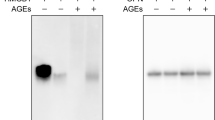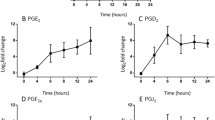Abstract
Background
We previously reported that advanced glycation endproducts (AGEs) increase the proinflammatory activity of high mobility group box-1 (HMGB1), a representative damage-associated molecular pattern molecule (DAMP), through their direct interaction. This suggested that AGEs activate other DAMPs and led us to search for novel DAMPs capable of interacting with AGEs.
Methods and results
The chromatographic analysis using AGE-immobilized gel revealed the ribosomal protein family to be a factor with binding activity to AGEs. Ribosomal protein L9 (RPL9), a member of the ribosomal protein family, was found in the centrifugal supernatant of ruptured cells and in the serum of lipopolysaccharide (LPS)-stimulated sepsis model mice, exhibiting similar characteristic properties to HMGB1. Although HMGB1 potentiated LPS-stimulated TNF-α expression in macrophage-like RAW264.7 cells, RPL9 hardly exhibited this activity. Of note, RPL9 significantly suppressed the potentiated mRNA expression and protein production of TNF-α by HMGB1 plus LPS stimulation, suggesting its regulatory roles in DAMP-induced proinflammatory activity. Based on the differential scanning fluorimetric analysis, the direct interaction between RPL9 and HMGB1 may play a role in the suppressive effects of RPL9.
Conclusions
This study suggested that RPL9 is a novel type of DAMP with a regulatory role in the proinflammatory response and provided insight into the pathophysiology of inflammatory diseases.



Similar content being viewed by others
Data availability
The data generated during and/or analyzed during the current study are available from the corresponding author on reasonable request.
Code availability
Not applicable.
References
Roh JS, Sohn DH (2018) Damage-associated molecular patterns in inflammatory diseases. Immune Netw 18:e27. https://doi.org/10.4110/in.2018.18.e27
Murao A, Aziz M, Wang H, Brenner M, Wang P (2021) Release mechanisms of major DAMPs. Apoptosis 26:152–162. https://doi.org/10.1007/s10495-021-01663-3
Watanabe M, Toyomura T, Tomiyama M, Wake H, Liu K, Teshigawara K, Takahashi H, Nishibori M, Mori S (2020) Advanced glycation end products (AGEs) synergistically potentiated the proinflammatory action of lipopolysaccharide (LPS) and high mobility group box-1 (HMGB1) through their direct interactions. Mol Biol Rep 47:7153–7159. https://doi.org/10.1007/s11033-020-05783-y
Aso Y, Inukai T, Tayama K, Takemura Y (2000) Serum concentrations of advanced glycation endproducts are associated with the development of atherosclerosis as well as diabetic microangiopathy in patients with type 2 diabetes. Acta Diabetol 37:87–92
Kanauchi M, Tsujimoto N, Hashimoto T (2001) Advanced glycation end products in nondiabetic patients with coronary artery disease. Diabetes Care 24:1620–1623
Li S-Y, Du M, Dolence EK, Fang CX, Mayer GE, Ceylan-Isik AF, LaCour KH, Yang X, Wilbert CJ, Sreejayan N, Ren J (2005) Aging induces cardiac diastolic dysfunction, oxidative stress, accumulation of advanced glycation endproducts and protein modification. Aging Cell 4:57–64
Srikanth V, Maczurek A, Phan T, Steele M, Westcott B, Juskiw D, Münch G (2011) Advanced glycation endproducts and their receptor RAGE in Alzheimer’s disease. Neurobiol Aging 32:763–777
Reynaert NL, Gopal P, Rutten EPA, Wouters EFM, Schalkwijk CG (2016) Advanced glycation end products and their receptor in age-related, non-communicable chronic inflammatory diseases; Overview of clinical evidence and potential contributions to disease. Int J Biochem Cell Biol 81:403–418
Watanabe M, Toyomura T, Wake H, Liu K, Teshigawara K, Takahashi H, Nishibori M, Mori S (2017) Advanced glycation end products attenuate the function of tumor necrosis factor-like weak inducer of apoptosis to regulate the inflammatory response. Mol Cell Biochem 434:153–162
Vivoli M, Novak HR, Littlechild JA, Harmer NJ (2014) Determination of protein-ligand interactions using differential scanning fluorimetry. J Vis Exp 91:e51809. https://doi.org/10.3791/51809
Watanabe M, Toyomura T, Mori S (2021) Application of differential scanning fluorimetry for analyzing molecular interactions: a model study on the interaction between glutathione S-transferase and glutathione, Shujitsu. Univ. J Pharm Sci 8:85–91
Hreggvidsdottir HS, Östberg T, Wähämaa H, Schierbeck H, Aveberger A-C, Klevenvall L, Palmblad K, Ottosson L, Andersson U, Harris HE (2009) The alarmin HMGB1 acts in synergy with endogenous and exogenous danger signals to promote inflammation. J Leukoc Biol 86:655–662
Hreggvidsdóttir HS, Lundberg AM, Aveberger A-C, Klevenvall L, Andersson U, Harris HE (2012) High mobility group box protein 1 (HMGB1)-partner molecule complexes enhance cytokine production by signaling through the partner molecule receptor. Mol Med 18:224–230
Taylor DJ, Devkota B, Huang AD, Topf M, Narayanan E, Sali A, Harvey SC, Frank J (2009) Comprehensive molecular structure of the eukaryotic ribosome. Structure 17:1591–1604. https://doi.org/10.1016/j.str.2009.09.015
Brodersen DE, Nissen P (2005) The social life of ribosomal proteins. FEBS J 272:2098–2108. https://doi.org/10.1111/j.1742-4658.2005.04651.x
Baik IH, Jo G-H, Seo D, Ko MJ, Cho CH, Lee MG, Lee Y-H (2016) Knockdown of RPL9 expression inhibits colorectal carcinoma growth via the inactivation of Id-1/NF-κB signaling axis. Int J Oncol 49:1953–1962. https://doi.org/10.3892/ijo.2016.3688
Yang J, Zhang P, Wang L (2016) Gene network for identifying the entropy changes of different modules in pediatric sepsis. Cell Physiol Biochem 40:1153–1162. https://doi.org/10.1159/000453169
Wang H, Ward MF, Sama AE (2014) Targeting HMGB1 in the treatment of sepsis. Expert Opin Ther Targets 18:257–268. https://doi.org/10.1517/14728222.2014.863876
Kang J-W, Kim S-J, Cho H-I, Lee S-M (2015) DAMPs activating innate immune responses in sepsis. Ageing Res Rev 24:54–65. https://doi.org/10.1016/j.arr.2015.03.003
Gavins FNE, Hickey MJ (2012) Annexin A1 and the regulation of innate and adaptive immunity. Front Immunol 3:354. https://doi.org/10.3389/fimmu.2012.00354
Halder SK, Matsunaga H, Ishii KJ, Ueda H (2015) Prothymosin-alpha preconditioning activates TLR4-TRIF signaling to induce protection of ischemic retina. J Neurochem 135:1161–1177. https://doi.org/10.1111/jnc.13356
Hangai S, Ao T, Kimura Y, Matsuki K, Kawamura T, Negishi H, Nishio J, Kodama T, Taniguchi T, Yanai H (2016) PGE2 induced in and released by dying cells functions as an inhibitory DAMP. Proc Natl Acad Sci U S A 113:3844–3849. https://doi.org/10.1073/pnas.1602023113
Land WG (2020) Use of DAMPs and SAMPs as therapeutic targets or therapeutics: a note of caution. Mol Diagn Ther. https://doi.org/10.1007/s40291-020-00460-z
Acknowledgements
This study was supported by JSPS KAKENHI Grant Numbers 21K06657 and 21K06701, the Kurita Water and Environment Foundation, the Sanyo Broadcasting Foundation, and the Wesco Scientific Promotion Foundation.
Funding
JSPS KAKENHI Grant Numbers 21K06657 and 21K06701, the Kurita Water and Environment Foundation, the Sanyo Broadcasting Foundation, and the Wesco Scientific Promotion Foundation.
Author information
Authors and Affiliations
Corresponding author
Ethics declarations
Conflict of interest
The authors declare no conflicts of interest associated with this manuscript.
Ethical approval
Experiments using mice were approved by the animal care committee of Shujitsu University (No. 035–002).
Consent to participate
Not applicable.
Consent for publication
Not applicable.
Additional information
Publisher's Note
Springer Nature remains neutral with regard to jurisdictional claims in published maps and institutional affiliations.
Supplementary Information
Below is the link to the electronic supplementary material.
Rights and permissions
About this article
Cite this article
Watanabe, M., Toyomura, T., Wake, H. et al. Identification of ribosomal protein L9 as a novel regulator of proinflammatory damage-associated molecular pattern molecules. Mol Biol Rep 49, 2831–2838 (2022). https://doi.org/10.1007/s11033-021-07096-0
Received:
Accepted:
Published:
Issue Date:
DOI: https://doi.org/10.1007/s11033-021-07096-0




